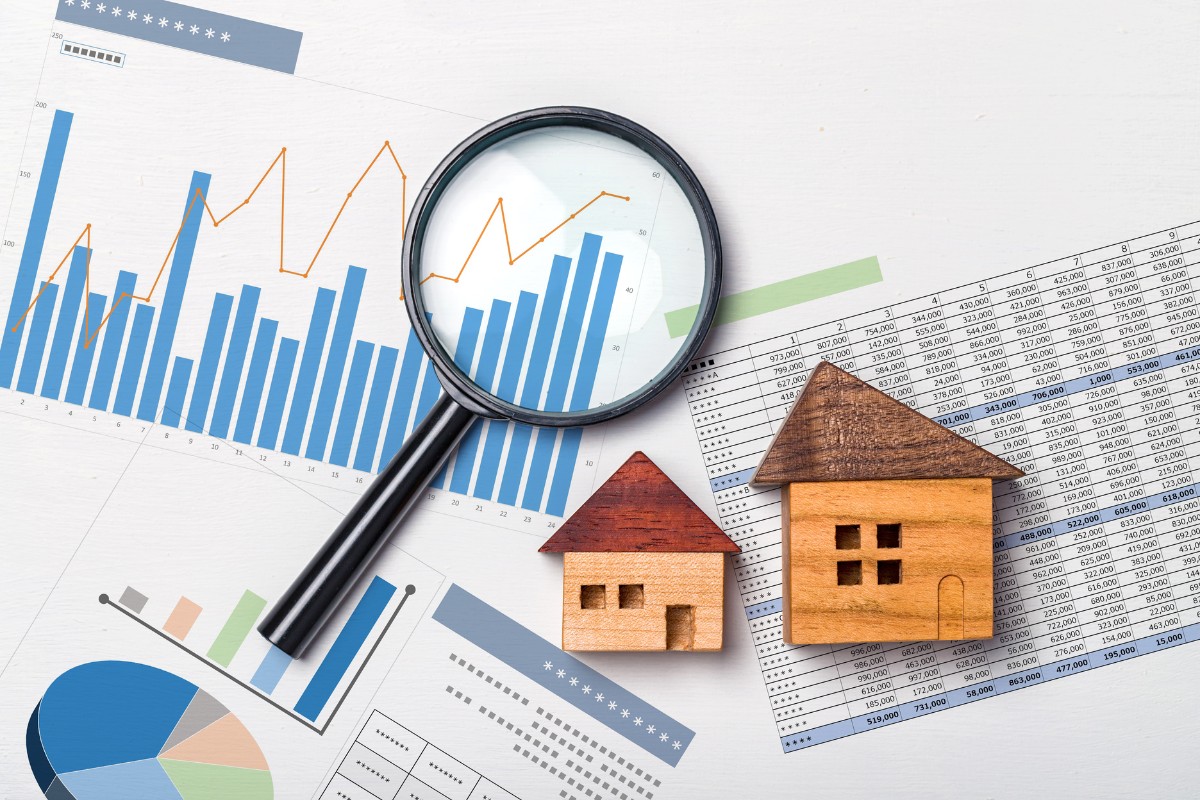With the housing market being pretty much in shambles, real estate statistics have garnered a lot of eyes in recent years.
An ever-changing industry that comes with many nuances, real estate is a necessary evil that almost everyone encounters at some point in their lives.
To give an example of this particular market’s size, all of the housing in the U.S. combined is worth roughly $43.4 trillion.
Nearly everyone will want to rent or own a home at least once, which makes for a constant demand in real estate.
There are many different aspects of the industry that can affect the market.
In this resource, you’ll get a detailed overview of a variety of statistics centered on the real estate industry.
Post Contents
Key Statistics
- As of Q1 of 2023, there are over 1.53 million realtors working in the U.S.
- 61% of recent buyers in the housing market were married couples
- 78% of current homebuyers bought their house with a mortgage
- The median age for first-time buyers in the U.S. is 36
- The commercial real estate market worldwide is worth roughly $34 trillion
- In 2023, the average down payment for a house was $24,100
- Those who finance the purchase of their home typically finance 94% of the total price
- 51% of buyers find their homes from sources on the internet
Top Real Estate Statistics in 2024: Breaking the Surface
When it comes to everyday people, they generally only concern themselves with what’s happening in the residential real estate market.
The truth is that real estate covers many different angles, some of which include commercial, residential, industrial, financing, and more.
Statistics on this topic provide insight into how the market has changed over the years and how it affects people on both sides of the industry.
Purchasing a home is one of the biggest investments that most people will make, which is why there’s so much stress and pressure on the industry as a whole.
By reviewing the statistics laid out in this article, you can get a better look at the past, present, and future state of the real estate market.

1. San Francisco has the Highest Median Selling Price for Real Estate in the U.S.
This may not come as a shock to those who live in the United States, but San Francisco is known to have the highest median selling price for real estate in the U.S.
California, in general, is expensive, but prices behind renting and owning homes in San Francisco is on another level.
Data from 2021 shows that selling prices for homes in San Francisco averaged around $1.36 million.
Although the market in this city can be brutal, it’s currently sitting in a neutral state.
San Francisco also comes with the highest average down payment for a house, coming out to 5%, or roughly $68,000.
It isn’t a city that’s welcoming to everyone, as you have to be pretty financially secure to make it in San Francisco.
However, these numbers also highlight the issue the U.S. is going through in regard to real estate, as it’s all simply too expensive for most people at this time.
(Zippia)
2. The Number of Homes Sold in the U.S. in 2022
Although many people would say the U.S. housing market is in shambles, there are still plenty of people buying homes where they can.
In 2022, there were an estimated 5.95 million homes sold in the United States.
Even with economic challenges, this number has steadily climbed since 2011, which was only at 4.57 million homes per year at the time.
Even with the real estate market being extremely unpredictable and costly right now, house sales are expected to increase for 2023 as well.
Some of these sales merely come from necessity, as everyone needs a place to live, but others consider home buying a life goal.
It has been proven before that regardless of the state of the economy; people are still going to be buying homes, even if many of them are way overpriced.
Real estate is an industry that never sleeps and can include some staggering numbers.
At this time, the average person in the U.S. doesn’t have home buying at the top of their to-do list.
(Zippia)
3. Demographics on Homebuyers
As one might expect, some demographics of home buyers can be rather predictable.
For example, recent statistics show that 61% of homebuyers were married couples, which is understandable as marriage and homebuying tend to go hand in hand.
When you dig further, you’ll find the following data on other groups such as:
- 17% were single females
- 10% were unmarried couples
- 9% were single males
Many people will pair the idea of marriage, family, and a home together.
Those who don’t have a spouse or kids may not see the point in living in a house all by themselves.
Regardless of how you look at it, married couples have numerous reasons to buy a home, making it a much more common trope when you review the data.
(TheClose)
4. Homebuyers That Used a Mortgage
With everyday people, it’s pretty common to hear about a mortgage if someone recently bought a home.
This is because most people can’t buy the home they want in full, so they finance it and pay off the mortgage over the course of a set amount of years.
If you take a look at the most recent available statistics on the topic, it shows that 78% of homebuyers purchase their home with a mortgage.
This shows just how common the practice is, as it’ll be a part of the process for most homebuyers.
Outside of those who purchase a house for the sake of having a home, there are many people who do it for the investment value alone.
Even if they’re entering a 10 to 30-year mortgage, their goal may be to rent out the property and profit from it down the road.
(TheClose)
5. Total Number of Housing Units in the U.S.
In regard to residential real estate, there simply isn’t enough available housing on the market.
Statistics from 2021 show that the U.S. had roughly 142 million housing units at the time.
Considering an estimated 331+ million people are in the U.S., this makes for a competitive housing market.
It seems the number of housing units has been increasing over time, but it still isn’t enough in some cases.
Entire generations of people are looking for homes to buy, and many of them can’t find one that fits the criteria that work for them.
Homeownership is a hot topic in the U.S. right now, especially since Covid-19 started a few years ago.
Many people panicked or readjusted their priorities, setting their sites on a new home, but the market came with competition that quite a few of them didn’t expect.
(Statista)
Stats From Different Real Estate Markets
As mentioned earlier, most people only concern themselves with residential real estate, but the industry focuses on many different facets.
The market for housing or industrial and commercial real estate can vary drastically based on the state, economy, and many other unique factors.
In the United States, some regions are known to be more affordable than others, while some are regarded as great choices for investment potential.
Real estate comes with a never-ending list of nuances that play into the cost of a home at any given time.
This makes for fluctuating real estate markets all across the U.S.
6. Which States Have the Most Competitive Real Estate Markets?
The cost of living in the U.S. shifts significantly from one state to the next.
For those who live in the country, most are well aware of which states offer the most affordable or expensive housing options on the market.
Of course, the numbers behind each state are bound to actively change with each passing year, but there are some traits that tend to remain the same for the most part.
In the table below, you can get a look at how real estate markets differ between 10 states in the U.S.
| State | Homes Sold Above Listing Price | Avg. Homes Sold in Less Than Two Weeks per Month | Avg. Supply of Homes per Month |
| Washington | 44.74% | 68 | 1.27 |
| Minnesota | 41.87% | 48 | 1.73 |
| Utah | 40.67% | 50 | 1.50 |
| Oregon | 38.87% | 56 | 1.71 |
| Nebraska | 38.80% | 68 | 1.13 |
| Virginia | 37.34% | 45 | 1.57 |
| Colorado | 34.46% | 55 | 1.94 |
| Idaho | 29.51% | 59 | 1.30 |
| Kansas | 27.16% | 55 | 0.00 |
| Indiana | 25.24% | 65 | 1.23 |
You’ll find a broader range of numbers if you were to include the rest of the states, but this list provides enough data for a general overview.
Aside from the specific numbers mentioned above, most people are concerned with how expensive it is to live in a particular location.
(Zippia)
7. The Most Expensive Cities

Although there are many considerations that go into the cost of living for any given city, you can get a general idea of what home buying looks like by reviewing a few key points.
Numbers that can be helpful in regard to this topic include the median selling price, listing price, and average price per square foot.
| City | Avg. Square Foot Price | Median Selling Price | Median Listing Price |
| Manhattan, NY | $1,400 | $950,000 | $1.6 million |
| San Francisco, CA | $1,100 | $1.36 million | $1.3 million |
| Boston, MA | $760 | $692,000 | $770,000 |
| Brooklyn, NY | $720 | $799,000 | $730,000 |
| Honolulu, HI | $700 | $610,000 | $625,000 |
| San Jose, CA | $610 | $983,000 | $925,000 |
| Los Angeles, CA | $550 | $760,000 | $860,000 |
| Oakland, CA | $525 | $757,000 | $690,000 |
| Seattle, WA | $520 | $751,000 | $690,000 |
| Bethesda, MD | $500 | $848,000 | $1.2 million |
With the diversity and sheer size of the U.S. landscape, citizens have many different real estate markets to choose from.
As many people know, California is one of the most expensive states in the country, with four cities in the list mentioned above.
(Zippia)
8. Working as a Realtor Can be Competitive
Even with how massive the real estate market is in the U.S., there’s no shortage of real estate agents to get the job done.
Those who are successful in the market can enjoy lucrative careers, but the number of realtors in a particular area can make for some substantial competition.
Here are the number of realtors in a few prominent states throughout the U.S.:
- Florida – 217, 886
- California – 198,119
- Texas – 147,154
- New York – 62,491
- Georgia – 46, 479
- Colorado – 28,520
Some of this is simply supply and demand, but there are plenty of markets that are oversaturated.
While there will always be wildly successful realtors, many others are working hard among thousands of others to grow in the industry.
(TheClose)
9. Housing Markets Across the World
Many of the statistics in this article so far have primarily focused on the United States, but the world of real estate knows no bounds.
Among laws, regulations, industry specifics, and even traditions, real estate can work differently in various parts of the world.
In the list below, you can find some unique statistics surrounding real estate in different regions.
- It costs roughly $4,459 per square meter for a home in Catalonia, Spain
- Germany holds the total number of housing units in Europe, sitting at 43 million units
- Sydney has the highest median residential property value in Australia at around $648,271
- Munich has the most expensive apartments in Germany, as high as $10,758 per square meter
- The monthly housing price index in London has been increasing for years, hitting a high of 133.43 in December of 2022
It’s understandable to only be concerned with real estate within your own country, but it’s a complicated industry no matter where you look.
The cost of living seems to be rising in many developed parts of the world, and it has been posing challenges for citizens everywhere.
You’ll find that many people consider the topic of real estate to be rather confusing, as it requires many considerations before the process is all said and done.
Whether you’re looking to rent or buy a home, it’s a process that requires a lot of research, time, and patience.
(Statista)
10. How Realtors are Using Tech
In our digital era, it’s wise for any business professional to use technology to manage business operations, clients, sales, and more.
Real Estate agents make use of technology in quite a few ways.
This is to get their name out there while remaining a relevant, trustworthy face in the local, national, or international markets.
The following information comes from a recent report done by the National Association of Realtors (NAR).
Most real estate agents prefer digital communication for efficiency and record keeping.
It seems 93% of them prefer to communicate with clients through text, 90% through phone calls, and 89% prefer e-mail.
Aside from that, 69% of realtors have their own website.
With realtors that have a membership with NAR, 74% of them use Facebook, and 56% use LinkedIn to manage their professional online interactions.
10% of members get 6 to 10% of their clients from social media, while 20% of members get 1 to 5%.
This data may only cover a report that includes NAR members, but it still shows a few trends in preferences when it comes to the work of a real estate agent.
(NAR.Realtor)
Data From the Housing Market
Between real estate agents and the housing market itself, there are a lot of statistics involved.
The U.S. has been going through unprecedented times over the last few years, as the economy has been hard on millions of citizens.
However, by reviewing the most recent stats on the U.S. housing market, you can get a more thorough understanding of why it’s drumming up so many headlines lately.
Although there are still affordable places to live in the U.S., this is becoming increasingly difficult for more urban areas.
11. Average Down Payment for a Home
Based on current data for 2023, the average down payment for a home in the U.S. is $24,100.
This number is actually relatively modest, even if it doesn’t seem like it.
To explain further, this number generally accounts for only 13% of the borrower’s total loan value.
There are many caveats involved in the final down payment for a home, and it’s bound to vary greatly, but roughly $24,000 is the current average for the U.S.
It’s bound to be higher or lower as time moves on, but the housing market in the U.S. is considered to be in shambles right now.
This is at least true for the everyday individual, as it can feel like a competitive sport to buy a home in the U.S. right now.
You’ll always find a direct correlation between the average down payment and the median cost of a new home.
In the U.S., it’s definitely on the higher side at this time.
There’s always going to be a demographic of people who find it affordable no matter what, but for most, the asking price is a little out of touch for what you get in some cases.
(Zippia)
12. What’s the Median Cost of a New Home in the U.S.?
In about the span of 20 years or so, the median cost of a new home in the United States has essentially doubled.
At this time, the number is around $436,800, which is staggering for many people.
Back in 200, the median cost was merely $207,000 in comparison.
One could make the argument that wages have changed as well, but this isn’t the case for everyone, or most people for that matter.
Although prices are high for 2023, data shows that they were actually a bit lower for 2021 and 2022.
Nevertheless, the market is always changing, but it can take some time to see something significant.
Historically, the housing market has taken years to deliver any kind of substantial change.
Then again, all it takes is one catastrophic economic event, and it can change overnight.
With the rise of technology, it’s also important to mention that living patterns have changed quite a bit.
The living preferences people have nowadays are expansive and unique and consider many different ways of life.
This has inherently affected a variety of statistics in the real estate market over the years.
(Zippia).
13. Notable Shifts in the Real Estate Market

We’re currently in a time where real estate as a whole is changing on a global scale.
There are many shifts in the market that are posing challenges for buyers, renters, professionals, and everyone in between.
Nevertheless, many of these happenings are inevitable for the sake of change, while others stem from economic events.
- In 2022, roughly 17 million people in the U.S. identified as digital nomads. This is up 131% from 2019 and shows that millions of people have no interest in maintaining a property.
- More population loss than gain is found in counties with resident numbers of 10,000 or less. Loss and gain correlate to 60.8% and 38.3% respectively.
- In the U.S., the most affordable states to live in are Mississippi, Kansas, Alabama, Oklahoma, and Georgia
- Counties with populations of 100,000 or more experienced significant increases in population of up to 68%
Real estate isn’t an easy topic to dive into, but it’s something that everyone should learn the basics of.
In one way or another, most people end up having to enter the real estate market to simply find a place to live.
(TheClose)
Final Thoughts
Now’s a great time to review these statistics as the market in the U.S. and the rest of the world is shifting as we speak.
A lot of what we have known about the market is going out the window as a new generation of home buyers emerges, looking for what works best for them.
Regardless of how you look at it, real estate is a stressful topic for most people, and the market as a whole can generate quite a few headaches.
Nevertheless, taking a look at real estate statistics can help alleviate some of the pain through knowledge and understanding.






























